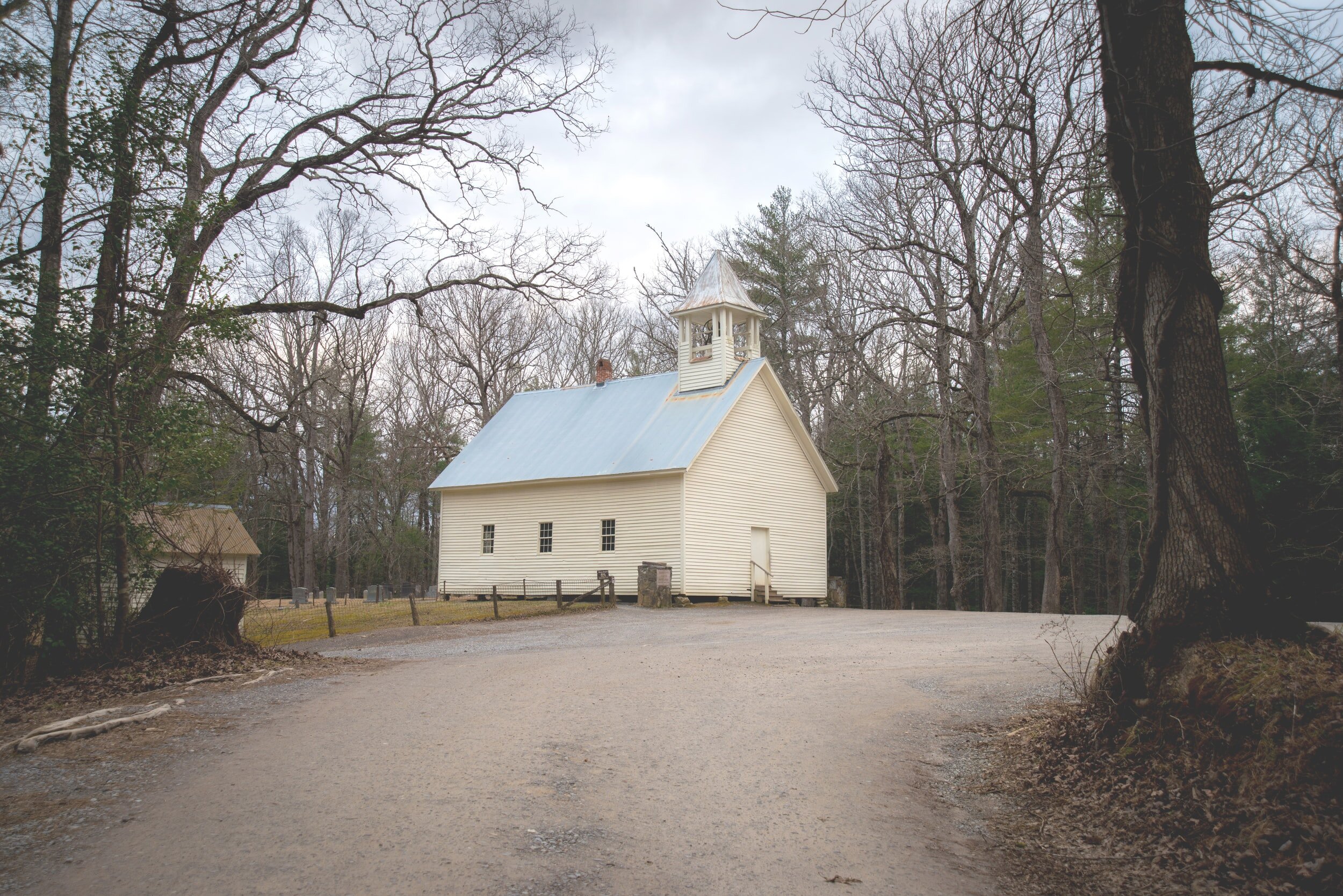Abandoned churches and the lessons they leave: an introduction
Cades Cove Primitive Baptist Church
Several years ago, I played the role of tourist while staying in the smoky mountains of southern Tennessee. We loaded the kids in the van, got out our area attractions map, and headed to a nearby national park called Cades Cove. It was a simple affair. A cove nestled in the bosom of mist-shrouded mountains. A pastoral valley cleared and tamed as the first settlers of European descent arrived some 200 plus years ago. It remained the home of the first settlers and their descendants until the 1930s, when the U.S. government acquired it for a national park. Today it remains not dissimilar from what it was in the 1930s. A pocked and bumpy paved road now traverses what was once a pocked and bumpy dirt road that encircles the valley.
Today, only a few cabins and farm buildings remain. These structures no longer have a purpose as part of working farms but now are preserved as museum pieces. What once was a place where life was hard and laborious is now a scenic drive full of valley vistas and remarkable sightings of turkey, deer, and other wildlife that have grown accustomed to the slow-moving vehicles with their staring faces and clicking cameras. And yet they do remain. The cabins still show the hewing marks of their builders and original owners. The barns, still holding hollowed logs, worn smooth from their former duty of offering the grain and straw to hungry livestock. The cabins, mills, smokehouses, and barns, the plows, wagons, and planters warn and seasoned with use and age still look as though they could return to duty at this very moment. Yet every visitor knows that all these things– the houses, the mill, and the barns - the wagons, the plows, and farm implements have life no longer as useful tools but rather as museum relics of the past. They represent not what is or will be but what was and will be no longer.
I do enjoy such places. I am fascinated by how things used to be. And though I am not nostalgic to the point of desiring a return to such ways, I am all the same intrigued by the way of life of those who so recently lived before us. Walking from our air-conditioned vehicle, which was navigated by a constellation of satellites, and carrying my mobile phone now made quiet by the lack of service in this remote local - silencing the announcement of calls, voicemails, emails, and refusing my request to update Twitter, Facebook, or even retrieve Google facts about my location - I approached the home of one who once lived here in a one-room log cabin. The only heat was from a stone fireplace, and the only source of survival was the fields that tumble and roll all around it. Seemingly foreign to my own technologically advanced world, this scene would have been familiar to my grandparents. I was happy to explore the remains of a past era, only to return to my air-conditioned, satellite navigated vehicle, to return to someplace where my phone would again come to life with cell service. Beyond the beautiful scenery and opportunity to observe the relics of a previous era, I discovered that there were lessons to learn and a witness to our present day from the old buildings that remain.
As industrialization transformed the world and later the advancements of technology touched everything from farming to the kitchen, the world has radically changed from the world that the inhabitants of this valley knew. These buildings show us how we used to live. They testify to a way of living that is only separated from our present-day by a few generations. Yet, the chasm of differences seems much greater than the years would indicate. The original inhabitants of this valley knew a nation of farmers. They would not understand the world we inhabit of interdependent laborers whose work makes little that is tangible and consume products produced on a mass scale. Though there are few common links between the economies and ways of life of the people of this valley and our present-day, I did find familiar ground. Among the smattering of cabins and farm buildings remain three buildings isolated from each other only by trees and a few hundred yards. Remarkably similar in construction and form, they each maintain their uniqueness in style and apportion - the three churches of Cades Cove. Among these three buildings, I discovered both a common link with our day and a witness to our day.
All three churches are one-room structures. Each boasts whiteboard siding, a bell tower and steeple, and an adjacent cemetery. All three buildings were heated with a single wood stove situated in the middle of the room. The wooden pews are of simple construction, filling the back three-quarters of the room. They form two rows creating a center aisle that leads from the front door to the pulpit. A pulpit dominates the front quarter of each building. Each is flanked by built-in pedestals on each side and has a bench behind it for the preachers. On the floor, in front of each pulpit, is a pew facing the congregation for those considering spiritual decisions. On the pulpit's left and right are additional pews perpendicular to those in the back three-quarters of the room for additional seating. The only storage in the churches were small compartments built inside the pulpits that afforded enough room for a songbook or two.
There are differences between the three buildings. The Primitive Baptist church was the most simplistic of the three. It is a rectangle building, with its only door being the double doors at the front. When these doors stand open, it adds to the light from the simple windows on the other three walls. The Methodist church has a cross adorning the wall behind the pulpit and has the distinction of having two separate front doors. The Missionary Baptist Church, the latest to be constructed, is the most elaborate. It alone boasts a small vestibule, a bay window area behind the pulpit, and a door exiting the rear of the building. Though the three buildings are similar, the theological differences between the congregations they housed were significant. History tells the story of cooperation and mutual use of the buildings amongst the congregations. It also tells the heart-breaking tale of congregations splintering over theological issues. Not that the issues were not worthy of great theological debate, even separation, but heart-breaking all the same.
As I walked through the three buildings, imagining the ministries they once housed, the people who once sat in the pews, and the pastors who preached in the pulpits, I was struck by what these now-silent buildings could say to present congregations. As I explored the buildings and pondered what they once were and have become, three ideas came to mind: simplicity, legacy, and ministry.
Simplicity: These churches reflected the simplicity and supremacy of preaching. They were built to provide a place for the gospel to be preached.
Legacy: These churches still bear witness to their legacy in the graves that are adjacent to each church. Intermingled among the old tombstones are recent graves testifying to the continuing legacy of each church.
Ministry: When the population left, these churches were left without a community to minister to and thus without a ministry. Some tried to keep the churches functioning even though the community was no more, but this proved to be purposeless.
In the following weeks, I plan to reflect on each of these themes and what these three old church buildings that seem so separated from our present-day can teach us about them.


